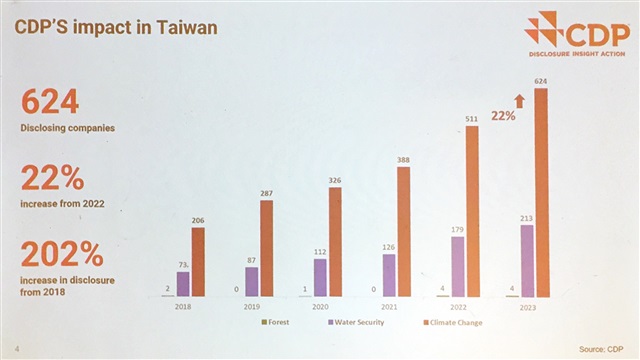Nicolette Bartlett, Chief Impact Officer at CDP (Carbon Disclosure Project), emphasized the importance of measuring and managing carbon emissions and sustainability efforts. Bartlett highlighted CDP's role in facilitating corporate disclosure and the significant growth in participation over the years.
CDP, with its mantra "what you can't measure, you can't manage," has been instrumental in urging companies to disclose their carbon emissions. Bartlett underscored the substantial increase in participation, from 200 companies initially to over 23,000 disclosing companies and 1,100 cities, states, and regions worldwide in 2023.

Credit: CDP
While the US, China, and Japan are among the top disclosing countries, Taiwan has emerged as a notable participant in this effort. Taiwan's disclosure increased by 22% in 2023, with 624 companies disclosing their data, including many first-time disclosers.


Credit: CDP
Bartlett outlined the various benefits of corporate disclosure, including access to capital, improved competitiveness, and compliance with regulations. She stressed the importance of transition plans, which help companies align their strategies with sustainability goals, and highlighted the increasing focus on adaptation measures alongside emissions reduction efforts.
Furthermore, Bartlett discussed the evolution of reporting standards and CDP's efforts to align with global frameworks, such as the ISSB S2 climate standards and the TCFD recommendations. ISSB, deeply rooted in accounting standards for financial actors, prioritizes assessing risks associated with climate impact, particularly in terms of value creation.
Unlike other frameworks, ISSB adopts an "outside-in" approach, emphasizing the risk climate change poses to businesses and investors' keen interest in understanding these implications. This perspective contrasts with the "inside-out" approach of assessing a company's environmental impact, which also remains important but secondary to understanding the broader climate risks.
The ISSB's standards encompass both perspectives, aligning closely with global efforts to address climate change comprehensively. Notably, the ISSB's initial standards, S1 and S2, focus on governance and climate-related disclosures, respectively. As the board progresses, attention will shift to incorporating social factors into these disclosures, ensuring a holistic approach to sustainability reporting.
For companies already engaged in initiatives like CDP, transitioning to ISSB standards should be relatively seamless, as these frameworks align closely. This alignment not only facilitates compliance but also enhances access to capital and strengthens business competitiveness.
Moreover, embracing sustainability reporting is not solely a regulatory compliance issue but a strategic move to secure market access and attract investors. This holds true for small and medium-sized enterprises (SMEs) as well, as buyers increasingly demand transparency and sustainability across their supply chains.
Recognizing the diverse landscape of corporate entities, policymakers are urged to ensure that climate reporting standards are efficient, globally aligned, and inclusive of SMEs and private actors. By providing incentives and support for companies to adopt these standards, governments can drive widespread adoption and facilitate a smoother transition to a more sustainable global economy.
Looking ahead, Bartlett emphasized CDP's commitment to continuous improvement, with plans to further streamline reporting processes, expand questionnaire options, and enhance support for enterprises. She urged companies to partner with CDP in this journey towards sustainability and assured stakeholders that ongoing efforts will lead to more effective and impactful outcomes in the future.

Credit: Nicolette Bartlett




